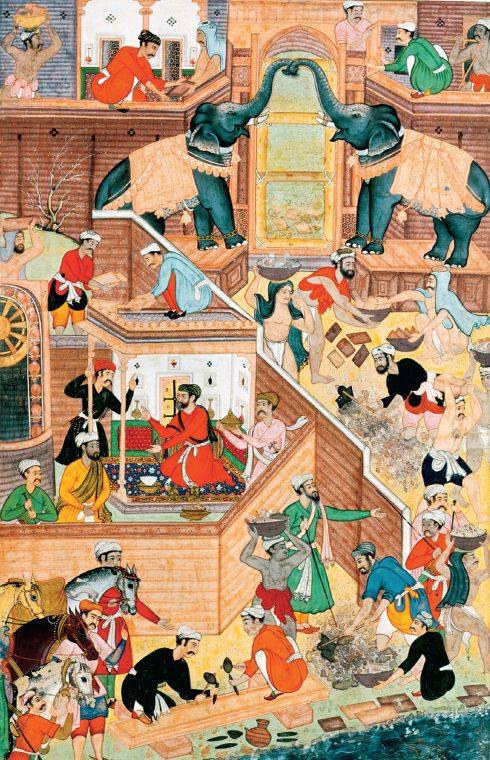Understanding World Societies:
Printed Page 499
> How did Christians, Jews, Hindus, and other non-Muslims fare under these Islamic states?

In 1569 Akbar founded the city of Fatehpur Sikri (the City of Victory) to honor the Muslim holy man Sheik Salim Chishti, who had foretold the birth of Akbar’s son and heir Jahangir. Akbar is shown here seated on the cushion in the center overseeing the construction of the city. The image is contained in the Akbarnama, a book of illustrations Akbar commissioned to officially chronicle his reign. (Victoria & Albert Museum, London, UK/The Bridgeman Art Library)
DDRAWING ON QUR’ANIC TEACHINGS, Muslims had long practiced a religious tolerance unknown in Christian Europe. Muslim rulers for the most part guaranteed the lives and property of Christians and Jews on their promise of obedience and the payment of a poll tax. In the case of the Ottomans, this tolerance was extended not only to the Christians and Jews who had been living under Muslim rule for centuries but also to the Serbs, Bosnians, Croats, and other Orthodox Christians in the newly conquered Balkans. In 1454 Rabbi Isaac Sarfati sent a letter to the Jews in the Rhineland, Swabia, Moravia, and Hungary, urging them to move to Turkey because of the good conditions for Jews there. A massive migration to Ottoman lands followed. When Ferdinand and Isabella of Spain expelled the Jews in 1492 and later, many immigrated to the Ottoman Empire.
The Safavid authorities made efforts to convert Armenian Christians in the Caucasus, and many seem to have embraced Islam, some more voluntarily than others. Nevertheless, the Armenian Christian Church retained its vitality, and under the Safavids Armenian Christians were prominent merchants in long-
Babur and his successors acquired even more non-
Akbar went the furthest in promoting Muslim-
Some of Akbar’s successors, above all Aurangzeb, sided more with the ulama. Aurangzeb appointed censors of public morals in important cities to enforce Islamic laws. He forbade sati — the self-
>QUICK REVIEW
Which of Akbar’s policies were reversed by Aurangzeb? Why?